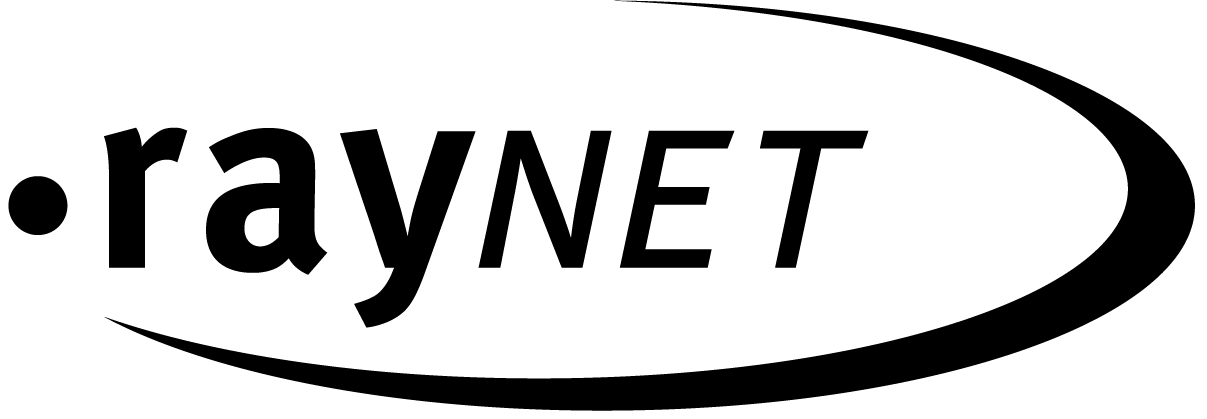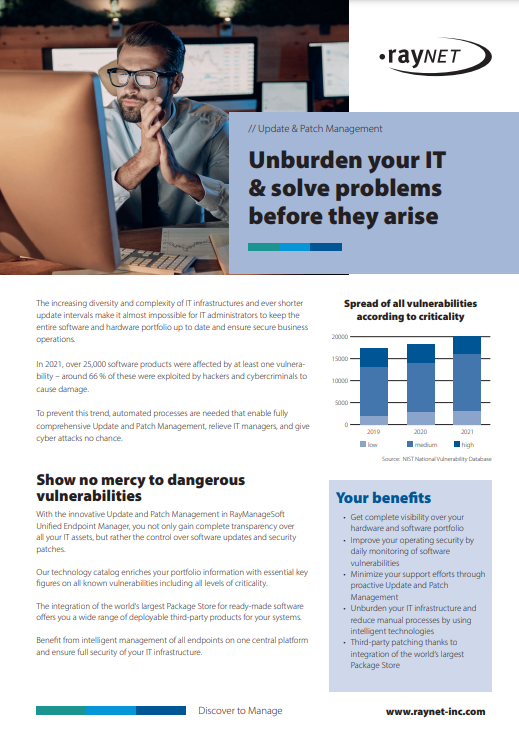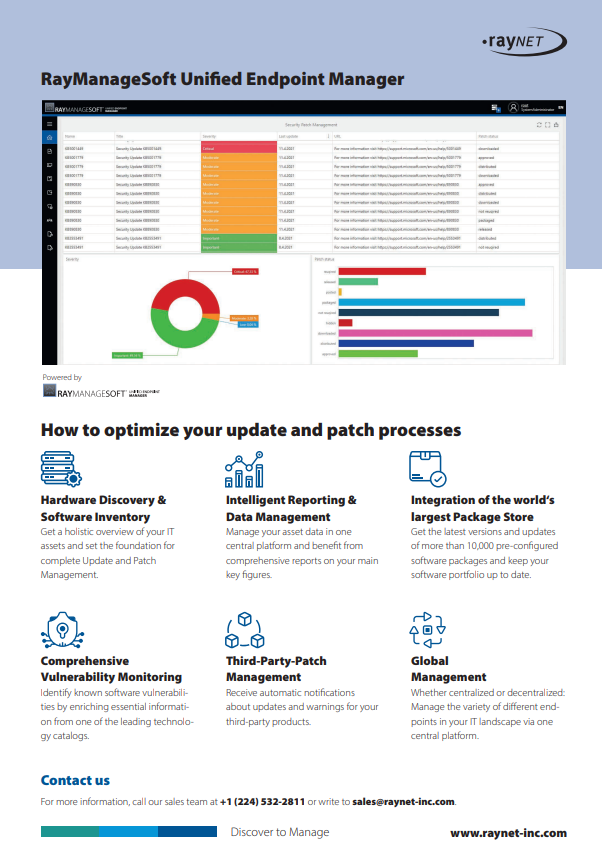Date: November 3rd, 2022
Midmarket enterprises face unique challenges in managing their digital endpoints. Although their goals are the same as any enterprise – keep costs low, optimize usage and purchasing, support business services, manage software portfolio, prevent sprawl – they may have fewer dedicated resources and are less specialized than larger enterprises. For instance, a midmarket enterprise may not have an FTE whose sole job is Endpoint Management. Instead, the work may be performed by several non- or semi-specialists who rely on services and/or third-party consultants.
Midmarket faces Unified Endpoint Management challenges
But the market in Endpoint Management solutions and services is built for large enterprises. In their recent report, “Midmarket Context: Magic Quadrant™ for Unified Endpoint Management Tools”, Gartner® writes, “Many UEM vendors focus on large organizations that have broad and complex product requirements. MSEs can find these products unwieldy and tend to look for vendors that actively build and target midmarket organizations.”
The products are unwieldy because they are designed for large and complex infrastructures with specific technical requirements and higher security requirements. The solutions are often on-premises and involve lengthy roll out periods; they are designed around expert users, are harder to learn, and require deeper ITAM experience, and coding skills.
For midsized enterprises, these requirements can add unnecessary costs and efforts to a process whose goal is to save money and time. Gartner continues, “MSEs should evaluate UEM vendors on their product capabilities, services, the ease with which they integrate into their existing ecosystem and price transparency”.
Unburden your IT & solve problems before they arise
The increasing diversity and complexity of IT infrastructures and ever shorter update intervals make it almost impossible for IT administrators to keep the entire software and hardware portfolio up to date and ensure secure business operations. Do you belong to it too?
What midsized enterprises are looking for in a Unified Endpoint Management solution
Capabilities, services, and ease of integration are key factors for midsized enterprises looking to control their IT environment while making strategic portfolio management decisions.
- Midsized enterprises are looking for comprehensive solutions that have a broad range of capabilities. Tools that cover only one use case or one asset or asset type are costly and burdensome both for infrastructure and teams.
- Solutions need to be flexible, covering a whole range of products, asset types, and use cases.
- Cloud hosting allows midsized enterprises to stay lean and agile. However, some midsized enterprises deal with sensitive data that, for regulatory, legal, and contractual reasons, will need to be hosted on-premises on in a hybrid environment, and their UEM solution will need to be implemented accordingly.
- UEM solutions need to integrate with various adjacent tools, including Endpoint Security, Identity and Access Management (IAM), IT Service and Asset Management, and Vulnerability and Patch Management. These tools are indispensable for securing and managing enterprise IT environments, easy and quick integration ensures security, improves data quality and reporting, and increases visibility across the entire IT estate.
- Many midsized enterprises want tool providers with strong services or service providers with a strong range of tools. They have a low-commitment or hands-off approach to Unified Endpoint Management. Some enterprises will opt for a full-service offering where they can work with the service providers to make data-driven decisions, while others will use the services for set-up and continuous consultation. They will want to keep their teams free from management tasks to focus on business drivers.
- Midsized enterprises need turnkey solutions that integrate easily with existing solutions and infrastructure. No one really wants a tool that is hard to integrate with their existing infrastructure, but this is even more the case with midsize enterprises that want to stay lean and agile. Setup and on-boarding should move quickly and painlessly, and because their infrastructure may be in the public cloud, a UEM solution must have the right range of connectors, and advanced transformation and normalization capabilities.
Is Raynet’s Unified Endpoint Management solution the right fit for your midsize enterprise?
Raynet’s Unified Endpoint Management solution is fully scalable, integrates easily and quickly with hundreds of enterprise security and asset management solutions, and is supported by industry-leading services. Want your solution on-premises? No problem. In the cloud? We’ll help you get there. Need services to help you get started and to continually optimize your UEM program? We’ve got you covered.
Three Takeaways: “Midmarket Context: Magic Quadrant™ for UEM Tools”
Reading time: 4 minutes
November 3rd, 2022 | Joshua Brazee
Midmarket enterprises face unique challenges in managing their digital endpoints. Although their goals are the same as any enterprise – keep costs low, optimize usage and purchasing, support business services, manage software portfolio, prevent sprawl – they may have fewer dedicated resources and are less specialized than larger enterprises. For instance, a midmarket enterprise may not have an FTE whose sole job is Endpoint Management. Instead, the work may be performed by several non- or semi-specialists who rely on services and/or third-party consultants.
Midmarket faces Unified Endpoint Management challenges
But the market in Endpoint Management solutions and services is built for large enterprises. In their recent report, “Midmarket Context: Magic Quadrant™ for Unified Endpoint Management Tools”, Gartner® writes, “Many UEM vendors focus on large organizations that have broad and complex product requirements. MSEs can find these products unwieldy and tend to look for vendors that actively build and target midmarket organizations.”
The products are unwieldy because they are designed for large and complex infrastructures with specific technical requirements and higher security requirements. The solutions are often on-premises and involve lengthy roll out periods; they are designed around expert users, are harder to learn, and require deeper ITAM experience, and coding skills.
For midsized enterprises, these requirements can add unnecessary costs and efforts to a process whose goal is to save money and time. Gartner continues, “MSEs should evaluate UEM vendors on their product capabilities, services, the ease with which they integrate into their existing ecosystem and price transparency”.
Unburden your IT & solve problems before they arise
The increasing diversity and complexity of IT infrastructures and ever shorter update intervals make it almost impossible for IT administrators to keep the entire software and hardware portfolio up to date and ensure secure business operations. Do you belong to it too?
What midsized enterprises are looking for in a Unified Endpoint Management solution
Capabilities, services, and ease of integration are key factors for midsized enterprises looking to control their IT environment while making strategic portfolio management decisions.
- Midsized enterprises are looking for comprehensive solutions that have a broad range of capabilities. Tools that cover only one use case or one asset or asset type are costly and burdensome both for infrastructure and teams.
- Solutions need to be flexible, covering a whole range of products, asset types, and use cases.
- Cloud hosting allows midsized enterprises to stay lean and agile. However, some midsized enterprises deal with sensitive data that, for regulatory, legal, and contractual reasons, will need to be hosted on-premises on in a hybrid environment, and their UEM solution will need to be implemented accordingly.
- UEM solutions need to integrate with various adjacent tools, including Endpoint Security, Identity and Access Management (IAM), IT Service and Asset Management, and Vulnerability and Patch Management. These tools are indispensable for securing and managing enterprise IT environments, easy and quick integration ensures security, improves data quality and reporting, and increases visibility across the entire IT estate.
- Many midsized enterprises want tool providers with strong services or service providers with a strong range of tools. They have a low-commitment or hands-off approach to Unified Endpoint Management. Some enterprises will opt for a full-service offering where they can work with the service providers to make data-driven decisions, while others will use the services for set-up and continuous consultation. They will want to keep their teams free from management tasks to focus on business drivers.
- Midsized enterprises need turnkey solutions that integrate easily with existing solutions and infrastructure. No one really wants a tool that is hard to integrate with their existing infrastructure, but this is even more the case with midsize enterprises that want to stay lean and agile. Setup and on-boarding should move quickly and painlessly, and because their infrastructure may be in the public cloud, a UEM solution must have the right range of connectors, and advanced transformation and normalization capabilities.
Is Raynet’s Unified Endpoint Management solution the right fit for your midsize enterprise?
Raynet’s Unified Endpoint Management solution is fully scalable, integrates easily and quickly with hundreds of enterprise security and asset management solutions, and is supported by industry-leading services. Want your solution on-premises? No problem. In the cloud? We’ll help you get there. Need services to help you get started and to continually optimize your UEM program? We’ve got you covered.
Share this blog post:



